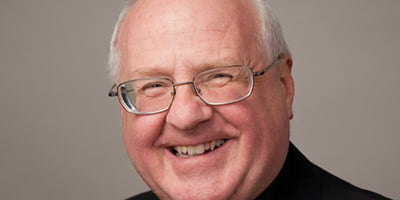
Father Mark Goldasich is the pastor of Sacred Heart parish in Tonganoxie. he has been editor of the Leaven since 1989.
by Father Mark Goldasich
“Hey, is it still OK to say ‘pagan babies’”?
This question was posed by Anita McSorley, the managing editor at The Leaven. You can guess my answer already if you’ve read our front-page story this week.
While I’m sure we’d never refer to children in mission territories today as “pagan babies,” it was common to do so at least a half century ago when I was in Catholic grade school. In fact, pagan babies got me into trouble and triggered the first phone call from the nuns to my parents. But more on that later.
Hanging on my parish office bulletin board is a colorful little card, dated April 23, 1963. On its front is an image of the Child Jesus (who is white), sitting down with a bowl of what looks like rice or soup in his lap. He has a spoon in his right hand but is not feeding himself. Instead, he’s offering the food to three small children: one Asian, one Hispanic, and one African.
Inside the card are the following words: “This Certificate is awarded to Mark Goldasich In Testimony of an Offering made to the Pontifical Association of the Holy Childhood for the Adoption of a PAGAN BABY who will receive the Name of Mary Ann in Holy Baptism.” It’s signed by both the national director of the Holy Childhood Association and the diocesan director (who was Father Louis Hauber).
I honestly can’t tell you how many pagan babies I “bought” over the years. As Nancy Berrigan recalls in our front-page story, the cost was $5, a pretty nice piece of change for a kid in those days. Unlike Berrigan, though, I never expected to receive an actual baby for my $5. I think I was just thrilled to get to name the kid. I have many of those certificates of adoption and, believe me, Mary Ann was probably one of the tamest names I gave those poor kids in the missions.
Although the term “pagan babies” might be insensitive today, the idea behind this program was sound. First and foremost, it made me aware as a kid that there was a big world out there and that everyone in that world didn’t enjoy the same blessings and security that I did.
Second, that picture of the Child Jesus on the front of the “adoption certificate” was a fantastic lesson in Christian charity: Care for the physical needs of hurting people first; you can preach to them later in words. I also like it that the three kids on the card look happy and nourished.
Finally, the Holy Childhood Association didn’t just raise our awareness, but gave kids a practical way to do something about the poverty in the world. In donating those pennies, nickels, dimes and quarters, we were not only learning a lesson of sacrifice (we could have bought candy for ourselves, for example), but we were being taught that our faith was to be more than a matter of words. Getting this lesson of donating early on made it a habit and a way of life for me.
While I don’t know exactly how this program was conducted in the missions, I suspect that not only were kids physically cared for, but they were given the faith and something equally necessary: hope.
I’ve always liked a story told by Halford Luccock, a teacher at Yale Divinity School in the early 20th century. At a dinner party, a guest was commenting on the fate of Flagstaff, Maine, a small town that was going to be flooded as part of a dam project. When the residents learned this, they stopped all repairs and improvements to their homes and property. The result was, of course, the town fell into ruin.
Understandably, the people in Flagstaff figured that since all was going to be underwater in six months, why keep up anything? That dinner guest then said, “Where there is no faith in the future, there is no power in the present.”
Through the Holy Childhood Association, pagan babies were given hope — hope that the future would be better for them and their eventual families. And when you have hope, you have a desire to learn and a motivation to work hard.
If you’ve not already done so, read our front-page story. It shows how much good can be accomplished by ordinary people who are “driven” by an extraordinary force, the grace of God within them. When you’re tempted to despair at the huge problems in the world and feel powerless to do anything about them, let Berrigan and her former Ward classmates show you one way to make the world a better place.
Oh, I almost forgot to tell you how pagan babies got me into trouble. Apparently, as a kid, I was always “flush” with cash for the pagan baby collection, especially on Mondays. One of the nuns called my folks to see if I was “lifting” funds from my mom’s purse or my dad’s wallet without their knowledge. My mom laughed and said the Monday money came from my uncles or other family members who would often visit on Sundays and slip me some spare change.
So, if you remember “pagan babies” — or even if you don’t — the needs of the poor in the world are still there . . . probably even more so. There are many organizations through which people can provide monthly financial support for poor kids all over the world. Listen to your heart this week and see if you’re being called to be an adoptive parent to them.
In providing for people in such a practical way, we can’t help but bring them hope. And that’s something you can’t put a price on.

